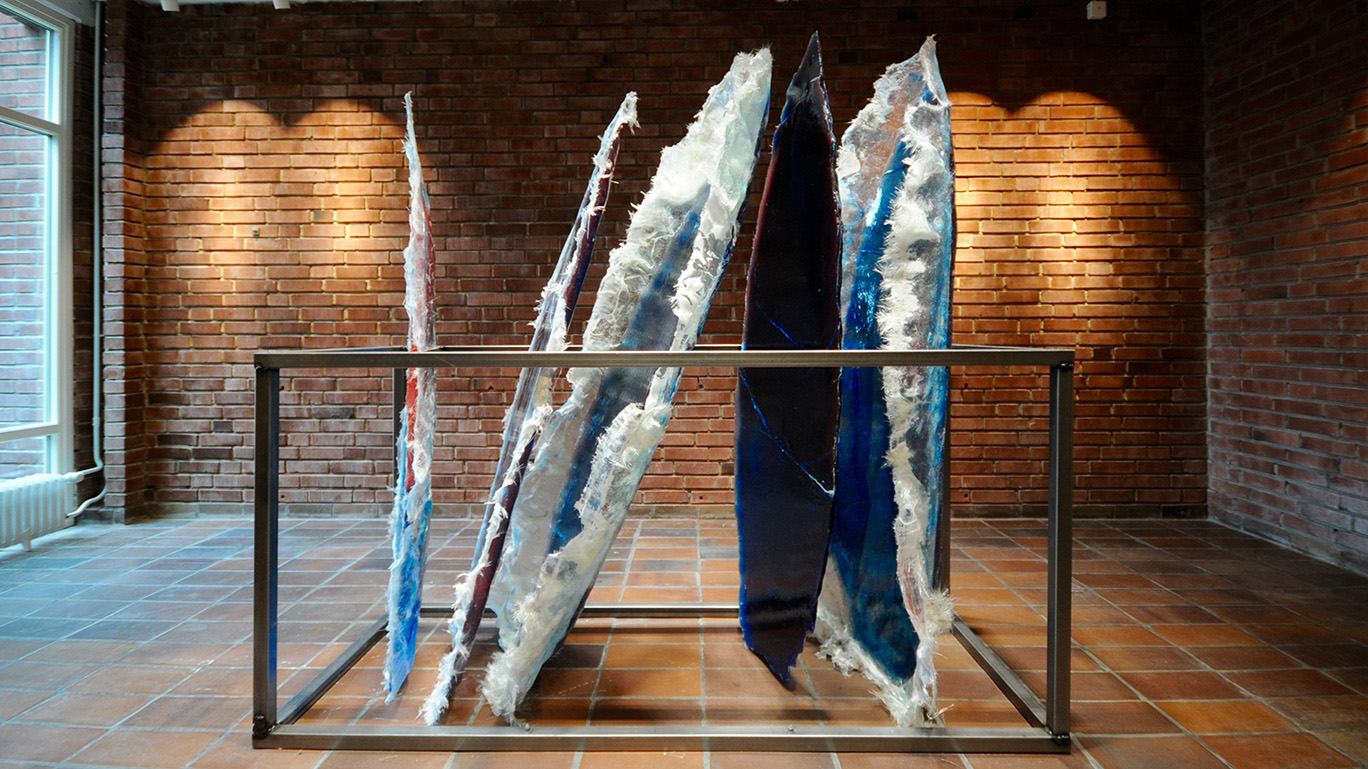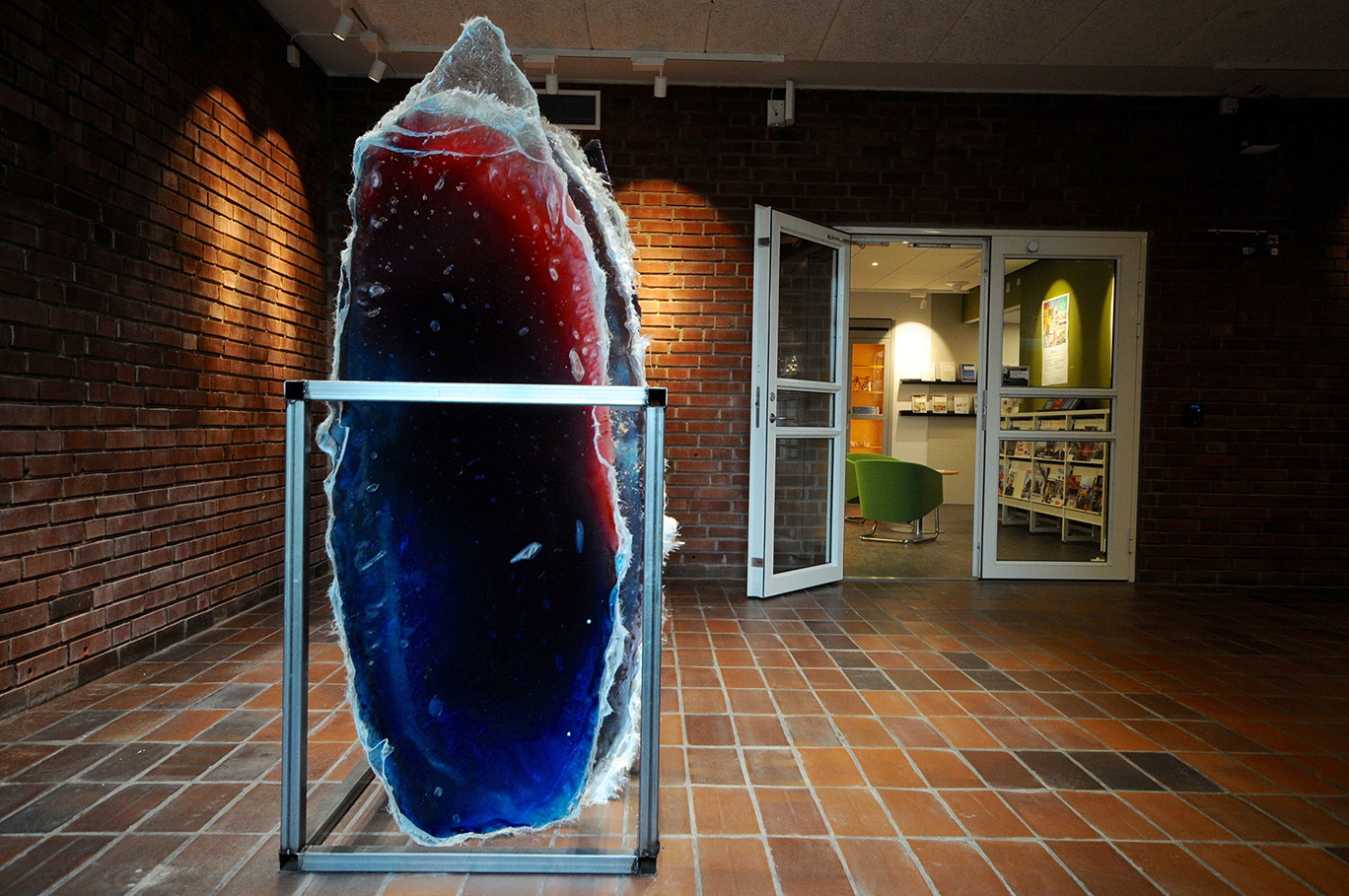Artist Tiril Hasselknippe’s sculptural group Surfboards (Vattenhuset), is located in the foyer of the V Building at the Faculty of Engineering (LTH) at Lund University. The work has a rough expression, a raw material that visualises its origin and the artist’s hand. Hasselknippe has been inspired by American popular culture and experiences of colour at Californian beaches. In the same building we also find the painting Cadillac Eldorado by the legendary artist John-E Franzén.




The artwork was completed in autumn 2016 at the Faculty of Engineering (LTH) at Lund University. In the V Building, courses are held in Building and Environmental Technology, Construction Sciences and Industrial Electrical Engineering. Points of contact between Hasselknippe’s choice of materials and the subjects exist. Polyester, one of the materials in the sculpture, is used for boats, cars and surfboards. The transparent and coarse expression of the fibreglass fabric opens up the construction to the viewer and each of the five sculptures has their own identity and personality.
On Tiril Hasselknippe
Tiril Hasselknippe was born in Arendal, Norway in 1984. She studied at the Malmö Art Academy. In her art practice, Hasselknippe is interested in sculpture as a physical object and as an extension of the person. Her artistic influences are taken from popular culture: literature, film, and art. The sculpture series Surfboards is particularly associated with surfing culture in California. Hasselknippe primarily works with sculpture, but she also writes impressionist texts. Surfboards (Vattenhuset) is Hasselknippe’s first site-specific sculpture for a public space. Tiril Hasselknippe resides in Oslo and Malmö.
Curator Kristina Möster Nilsson about Surfboards (The Water House)
Surfboards (Vattenhuset) by Tiril Hasselknippe is placed in the foyer of the V-building, the site of the Faculty of Engineering at Lund University, where students and instructors pass by on their way to the library or lecture halls. The Faculty of Engineering was designed in the 1960s by architect Klas Anshelm. It is a large campus studded with dark brick buildings. The architect intended that every new generation of students and artists in Lund make their mark and contribute to the architecture. V-building, with its engineering programs related to roads, water, and fire, represent a breadth of artistic material that interested Hasselknippe. Her choice of materials, generally speaking, is often closely associated with industrialism. Plastic, concrete, sand, and steel are a few that have a direct relationship to the programs housed in the V-building. In Surfboards (Vattenhuset), Hasselknippe focused on polyester and steel. The material tells a story about popular culture, vehicles, and California. The introduction to Hasselknippe’s artistic process was given through a painting that already hung in V-building, namely Surfboards Cadillac Eldorado (1966) by John E. Franzén. Both surfing and car cultures are closely associated with California and both artworks in the V-building have roots in a common history—with fifty years between them.
Hasselknippe works with a raw aesthetic. She allows the creation of the art to become visible when she exposes the material in rough cuts and finishes. For the curious, the entire casting process is visible in the sculptures of Surfboards (Vattenhuset). The transparency of the plastic material and its gradually encircling glass fiber tapestry reveals how the artist worked. The plastic cast was created by Hasselknippe and her assistant. Temperature and climate are crucial to the process, so the sculptures were cast during the summer months. The sculptures rest in a steel tripod welded by the artist. For Hasselknippe, it is important to develop a feeling for the material and to personally engage in an ongoing collaboration with it.
Each sculptural figure has a weight and proportion similar to a human body.
Hasselknippe’s experience of surfing as a sport: body, space, and senses rolled into one—formed the basis for Surfboards (Vattenhuset). The sculpture group is created in a color palette that builds upon the experience of color on California’s coasts. Each sculptural figure has a weight and proportion similar to a human body. Hasselknippe describes her experience of physical sculptural representation and surfing in this way:
“Surfing is like flying. The body is both moving and not moving. Your physical body is deconstructed and melts into the larger body underneath you. You fall off and into an embrace of sweeping magnitude. It pulls you around in directions you didn’t choose. You hold your arms up to protect yourself until you are resurrected as a human being.”
Find the artwork
Lunds Tekniska Högskola, John Ericssons väg, Lund, Sverige